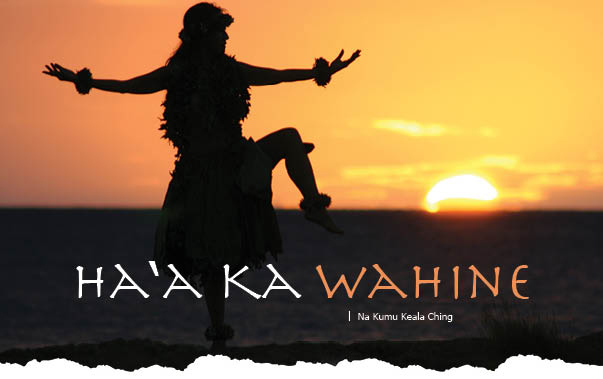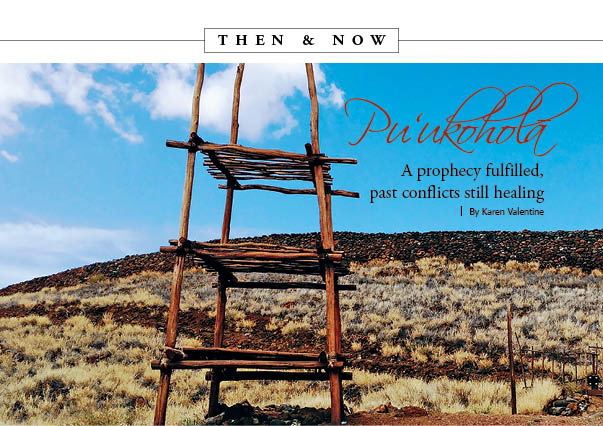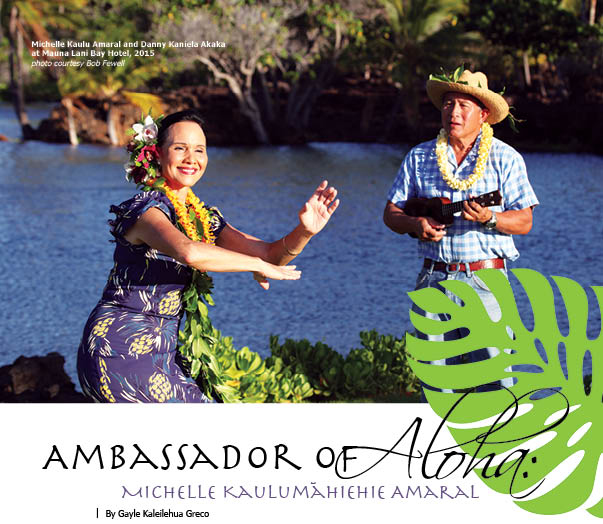
Wai‘ōpae Tide Pools in Puna: Unique Ecosystem Under Siege

By Denise Laitinen
A secluded coastline where bright tropical fish swim in calm, azure blue waters. Even the neighborhood overlooking this peaceful setting conjures images of paradise. Its siren call is hard to resist. Vacationland.
Located along the Puna coastline in the private subdivision of Kapoho Vacationland, the Wai‘ōpae Tide pools Marine Life Conservation District (MLCD), also known as the Kapoho tide pools, is probably one of the worst kept secrets on-island. In years past, it was the sort of hidden spot shared by kama‘āina who brought friends and family to snorkel in the tide pools.
Thanks to a burgeoning array of guidebooks, online blogs, and travel-related websites, an estimated 50,000–75,000+ visitors per year now frequent the tide pools, and residents say the number of visitors is increasing. It’s a unique situation because in order to get to the tide pools visitors must go through the private subdivision.
“Any given weekday you might see 25 cars parked here, not including the tour vans that carry around a dozen people each,” says Betty Hunter, a 15-year resident of Vacationland and secretary of the Kapoho Kai Water Board. “On the weekends, I’ll see upwards of 45 cars.”
In 2003, the state officials designated Wai‘ōpae tide pools as an MLCD, one of only 11 such areas statewide, in order to protect the marine resource. Similar to a barrier reef, a shallow basalt ridge causes waves to break off shore while tradewind-generated swells ensure that the pools still get excellent water circulation.
Making this community more unique is that many of the properties in Vacationland contain anchialine ponds that are interconnected to the tide pools. Derived from the Greek words anchi (near) and halos (the sea), anchialine ponds are land-locked bodies of water found next to the ocean. Varying in salinity levels, they have an underground connection to the ocean and their water levels vary with the tides.
Researchers still have a limited understanding of these ponds that are home to a variety of fish and crustacean species and are found in only a few parts of the world. Hawai‘i has among the highest concentration of anchialine ponds on the planet, with Hawai‘i Island having the most ponds in the state.
While the ponds are private because they are on residential property, the tide pools are a snorkeler’s delight.
“Kapoho tide pools host one of the most diverse and highest coral covers as far as east Hawai‘i reefs go,” says Misaki Takabayashi, a marine science researcher at the University of Hawai‘i, Hilo. Misaki knows these waters well. A marine scientist for the past decade, she has spent eight of those years specializing in coral ecology tracking coral health at the Wai‘ōpae tide pools.
Misaki is quick to point out the beauty of the tide pools, with their exquisite and unique environment. Yet she also notes that Mother Nature has not been kind to the tide pools in the past year. Two hurricanes and an extended El Niño weather pattern are taking their toll on the marine ecosystem.
Iselle Takes it Toll
Last August, Hawai‘i Island was bracing for back-to-back storms in the form of Hurricanes Iselle and Julio. Fortunately, Julio bypassed the island. However, Iselle, which was officially downgraded to a tropical storm shortly before it made landfall, struck in the early morning hours of August 8, 2014. With estimated peak wind gusts of 70-75 mph, Iselle brought high winds, torrential rains, high surf, and storm surge. The damage inflicted by the storm on the Puna district was unprecedented. Many communities, like Kapoho Vacationland, were without power for 14 days.
The low-lying community experienced storm surge of more than eight feet. More homes were destroyed in Vacationland than anywhere else in Puna, with a dozen homes completely destroyed. Roads were so severely blocked that it was days before officials and relief agencies knew the extent of the damage in Kapoho.
Entire homes were washed off their foundations and swept into ponds. Furniture, cement blocks, the contents of storage sheds, and the sheds themselves all wound up in the ponds. Streets within Vacationland were impassable for days due to debris and downed trees. Parts of the shoreline road where visitors parked to visit the tide pools looked like it had been through a blender.
Community Coming Together
In true aloha spirit, Puna residents in neighboring communities, themselves impacted by the storm, came to help residents in Kapoho Vacationland. Betty says, “The outer communities came to help their neighbors long before Civil Defense or the Red Cross showed up. There was so much help from other communities, such a compassion to help us out.”
That help and compassion was desperately needed given the level of destruction.
In the storm’s aftermath, the MLCD and a large portion of the Kapoho-Kalapana coastline were closed in order to assess the damage and conduct water quality samples. It was weeks before state officials with the Division of Aquatic Resources allowed access to the ponds again, and when they did, it was only to foot traffic. Visitors to the tide pools must now park at the entrance to the subdivision and walk to the tide pools, a distance of roughly half a mile.
In the weeks following the storm, large amounts of heavy equipment were brought into the neighborhood to remove debris, and two neighborhood clean up work days were held while researchers set about studying the impact of the storm.
Given her years of experience studying the coral in Kapoho, Misaki and her UH colleagues were asked to study the effects of the storm on the tide pools.
“A big reason why we could step in and assess the impact of Hurricane Iselle was because we already had a baseline of what a healthy reef looks like down there,” says Misaki. “We have healthy data sets of what the reef looked like before and after the hurricane.”
“There was absolutely no coral breakage in the marine conservation district on the south side,” adds Misaki. “On the north side, the average breakage outside of the marine life conservation district was six percent.”
Misaki notes that the UH scientists did not study theanchialine ponds because they are on private property. However, the Department of Health did conduct water quality testing on the ponds at the community’s request due to the extent of the damage.
Clearing and cleaning of the ponds required a massive coordinated effort that included everyone from the mayor’s staff to civic organizations and even correctional inmates who provided labor removing debris.
Over the course of two days in September 2014, more than 25 volunteers with assistance from County officials and various businesses removed 11.25 tons—more than 22,500 pounds—of Iselle storm surge related debris.
“We’re a close-knit community,” says Betty. “We all worked together.”
Various businesses, including a dive team from Nautilus Dive Center and volunteer divers from Project Aware helped out, as did numerous area residents and volunteers. Work day organizers single out state and county officials, such as John Kahiapo of the State Department of Land and Natural Resources (DLNR) Division of Aquatic Resources; Kevin Dayton, at the time executive assistant to Mayor Billy Kenoi; and District 4 Hawai‘i County Councilman Greggor Ilagan, as being particularly helpful in arranging for heavy equipment and dumpsters to be brought in to help in the cleanup effort.
“Greggor [Ilagan] and John [Kahiapo] were really instrumental in helping us getting our community back together,” says Betty. “DLNR was very helpful in getting us a container. The County helped a lot too; they brought in dumpsters.” With the overwhelming amount of debris removal that needed to be done in the small community, Ilagan and the mayor’s office coordinated efforts to have inmates from Hale Nani Correctional Facility assist in supervised clean up efforts. “The end of Kapoho Kai, where we used to have parking, was full of debris,” says Betty. “Those guys helped us get it to where it was presentable.”
Although much hard work went into those clean up workdays, volunteers were unable to remove all the debris. For months, future workdays were postponed due to the uncertainty surrounding the lava flow that was impacting the nearby Pāhoa community at the time.
And Mother Nature was not done with the tide pools. Hurricane Ana grazed Hawai‘i Island in October with storm surge and high surf. And while Ana’s impact was minimal compared to Iselle, Misaki says an even greater threat has been wreaking havoc on the tide pools.
“It was bad enough [the tide pools] got hit with two hurricanes, but what was really bad was that it was an El Niño year last year,” says Misaki. “The ocean temperature rose and the ocean circulation affected the water in the tide pools.”
Misaki explains that the tide pools are semi-confined. The porous nature of the region’s soil means that rainwater and storm water are soaked up like a sponge underground and discharged into the tide pools where they are flushed out during high tides. But during El Niño weather patterns, the tide pools are subjected to warmer water temperatures and the water doesn’t circulate as much as normal. The results can be devastating for coral found along the shoreline.
“Corals have algae that live symbiotically with them,” explains Misaki, “providing nutrients for the coral. When the coral lose those algae, it’s like their energy source is cut out of them.” When the algae die, the coral in turn become bleached and die.
“That’s what happened with last year’s El Niño. The coral in the tide pools sat in the elevated water temperature for months. That warm water killed off the algae resulting in bleaching and [the] coral died off.”
The impact on some of the coral species found in Kapoho was dire. In October 2014, just two months after Iselle struck, Misaki and her fellow researchers discovered that more than 80 percent of the blue rice coral found in the Wai‘ōpae tide pools was bleached and died due to the El Niño. Overall, 15 percent of all the coral species found at Wai‘ōpae were bleached as a result of El Niño.
She says that while El Niño has had a bigger impact than the hurricanes, all of the events affect the health of the reef. “It’s not just one stressor on the coral. It’s not just the hurricane or the water quality; it’s everything—a synergistic effect.”
“When a person has a lot of different stresses on them, such as family issues and work problems, they are more susceptible to disease. If we can help the coral with local stressors we can help them be better equipped against larger stressors like global warming and El Niño weather patterns.”
For its part, the community is doing what it can. Visitors must now park at the entrance to the subdivision and walk to the tide pools. The Kapoho Vacationland Community Association is in the process of installing portable changing rooms for visitors. There is a portable toilet available, although there are no permanent restroom facilities.
Vacationland residents met with Civil Defense Administrator Darryl Oliviera before the start of this year’s hurricane season to see what could be done to better prepare the community for future storms.
Marine scientists like Misaki remain concerned, especially in light of a continued El Niño weather pattern. She and other researchers are hoping they can continue studying the tide pools in Kapoho, and are challenged by funding issues. “What little emergency grants we were able to get ran out last March,” explains Misaki. “We’re now relying on donations to continue our research. ❖
What you need to know about Wai‘ōpae Tide pools:
- The tide pools are located within a private subdivision. Limited parking is available at the entrance to the community near the mailboxes.
- There are no lifeguards on duty at the tide pools. High surf and strong currents may occur during stormy weather conditions. Strong currents may also exist in some locations during periods of rapid tidal change.
- There are no permanent facilities at the tide pools. The closest public facility, including phones and toilets, is Ahalanui Beach Park, about 1.5 miles south.
- The MLCD’s maximum depth is about 13 feet and is not recommended for SCUBA diving.
- Kayaking is discouraged to avoid breaking coral in shallow water.
- Pick up trash, even if it is not yours. Trash can damage and kill a wide variety of marine life.
- Do not feed or pet the wildlife. Fish and other wildlife feed on their natural foods.
- Leave coral, shells, and rocks where they lay.
- If you are snorkeling, keep your fins, gear, and hands away from coral.
According to the State DLNR Division of Aquatic Resources it is illegal to do any of the following:
- To fish for, take, or injure any marine life (including eggs), or possess in the water any device that may be used for the taking of marine life.
- To take or alter any sand, coral, or other geological feature or specimen, or possess in the water any device that may be used for that purpose.
- To anchor or moor any vessel.
- To conduct commercial activities, including but not limited to commercial tours, dive groups, sightseeing tours, hikes, or guided services.
Getting to Wai‘ōpae Tide pools Marine Life Conservation District (MLCD)
The Wai‘ōpae Tide pools are located in lower Puna, about an hour drive south of the Hilo. Take Hwy. 130 heading south, then go east on Hwy. 132 to Hwy. 137. Travel about 1.1 miles south on Hwy. 137 and turn east (makai) on Kapoho Kai Drive. Follow road to parking areas marked by signs.
Donations can be made through the UH Foundation
Contact the writer


